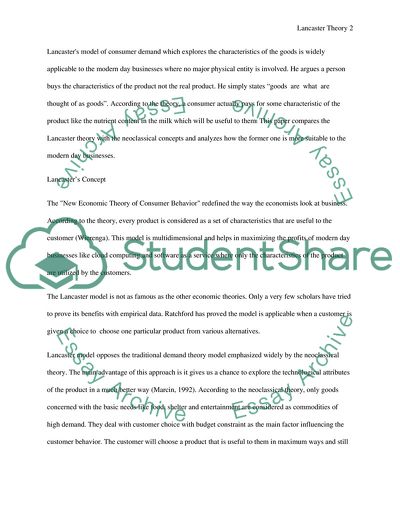Cite this document
(Compare lancasters 'characteristics' approach to consumer demand with Essay - 1, n.d.)
Compare lancasters 'characteristics' approach to consumer demand with Essay - 1. https://studentshare.org/macro-microeconomics/1791286-compare-lancasters-characteristics-approach-to-consumer-demand-with-the-standard-neo-classical-approach-what-is-lancasters-contribution-to-consumer-behaviour-analysis-and-how-far-does-this-reflect-the-modern-consumer-market
Compare lancasters 'characteristics' approach to consumer demand with Essay - 1. https://studentshare.org/macro-microeconomics/1791286-compare-lancasters-characteristics-approach-to-consumer-demand-with-the-standard-neo-classical-approach-what-is-lancasters-contribution-to-consumer-behaviour-analysis-and-how-far-does-this-reflect-the-modern-consumer-market
(Compare Lancasters 'characteristics' Approach to Consumer Demand With Essay - 1)
Compare Lancasters 'characteristics' Approach to Consumer Demand With Essay - 1. https://studentshare.org/macro-microeconomics/1791286-compare-lancasters-characteristics-approach-to-consumer-demand-with-the-standard-neo-classical-approach-what-is-lancasters-contribution-to-consumer-behaviour-analysis-and-how-far-does-this-reflect-the-modern-consumer-market.
Compare Lancasters 'characteristics' Approach to Consumer Demand With Essay - 1. https://studentshare.org/macro-microeconomics/1791286-compare-lancasters-characteristics-approach-to-consumer-demand-with-the-standard-neo-classical-approach-what-is-lancasters-contribution-to-consumer-behaviour-analysis-and-how-far-does-this-reflect-the-modern-consumer-market.
“Compare Lancasters 'characteristics' Approach to Consumer Demand With Essay - 1”. https://studentshare.org/macro-microeconomics/1791286-compare-lancasters-characteristics-approach-to-consumer-demand-with-the-standard-neo-classical-approach-what-is-lancasters-contribution-to-consumer-behaviour-analysis-and-how-far-does-this-reflect-the-modern-consumer-market.


